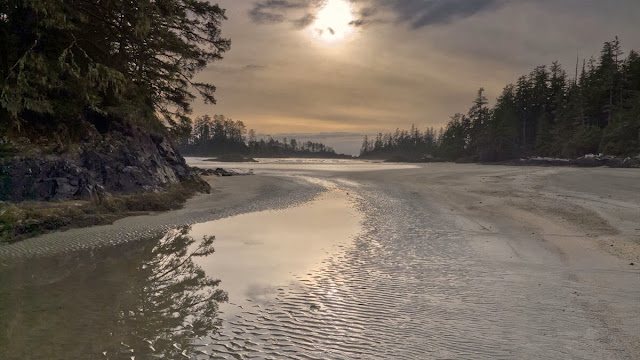Today, however, a mild day with some sunshine lured us out and we headed for the north end of Long Beach to the Incinerator Rock parking area. (We're still not sure what that name refers to... more research is needed!) From there, we headed north along the beach and walked up to Schooner Cove. Wow, what a beautiful area.
Today, I wanted to travel very light and just brought my little Panasonic LX5 point-and-shoot camera. Following my usual pattern of ambling along, generally nearer the back of the beach than at the waterline, I seek out the eye-catchers, looking for ways that best portray the individuality of what I see.
There is so much we see that we have no clue about. The above picture shows what looks like a tiny volcano, and we conjecture that there is in fact a clam or other marine creature buried in the sand below. Hundreds of them dot the beach near the waterline and one can imagine colonies of fascinating creatures existing in a three-dimensional plane (both below the sand and the water itself) that we Flatlanders rarely enter.
Over the past few weeks, in an attempt to try to start to understand all this, I worked my way through a recent text on Oceanography which was both fascinating and intimidating... there is SO much to learn. And SO much that we still don't know! Generally, I may have two or three books on the go at once, and currently, one I'm reading is Bill Bryson's wonderful book A Short History of Nearly Everything. Within it, he speaks of the oceans, and makes the point that we know almost nothing about them. Here is a quote:
Among other incredible tidbits is the fact that there is enough salt in the oceans to cover every spec of land to a depth of 500 feet! Or did you know that due to centrifugal force from the eastward spin of the earth, the western edge of the Pacific is a foot and a half higher? Here's another gem:“It's rather as if our firsthand experience of the surface world were based on the work of five guys exploring on garden tractors after dark. According to Robert Kunzig, humans may have scrutinized “perhaps a millionth or a billionth of the sea's darkness. Maybe less. Maybe much less.”
Excerpts From: Bill, Bryson. “A Short History of Nearly Everything.” Crown Publishing Group, 2003-04-13T04:00:00+00:00. iBooks.“Roughy are extremely long lived and slow maturing. Some may be 150 years old; any roughy you have eaten may well have been born when Victoria was Queen. Roughy have adopted this exceedingly unhurried lifestyle because the waters they live in are so resource-poor.”
So much to see, so much to ask about, so much to learn. It really is one of the reasons we are here, not just to enjoy this remarkable ecology, but to learn its secrets, its wonders. There are just so many seemingly disparate processes, events and objects that intricately mesh and intertwine to produce what we simplistically call Mother Nature.
Well, probably enough waxing eloquent for now, so here are some more images for you:
The next time we do this beach, we are going to tackle it from the trail closer to Schooner Cove, so I'll have some different images to showcase. As we started back down the beach to the car, the clouds were moving in from the west, a precursor to the next couple of days of rain. Perhaps we'll do the Rainforest Trail tomorrow... the forest is always magical in the rain, so alive and verdant.
So much to see...
Ciao for now.











No comments :
Post a Comment